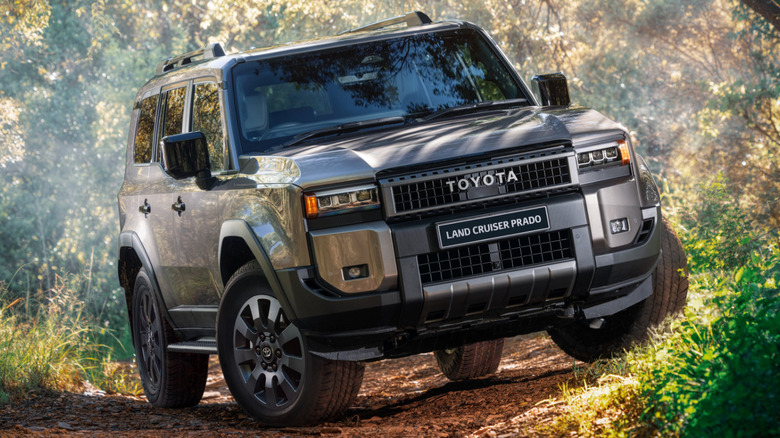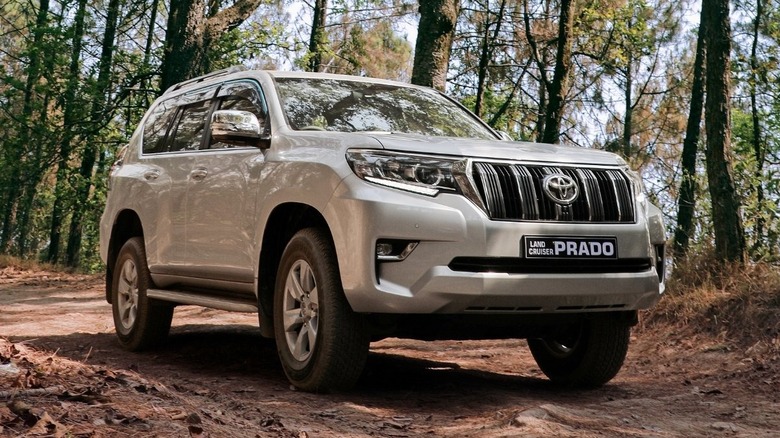What Does The Land Cruiser's 'Prado' Name Mean And Where Does Toyota Build The Model?
Toyota's Land Cruiser Prado has become a favorite among off-road lovers over the years, and for all the right reasons. People consider this SUV tough, spacious, comfortable, reliable, and ready to go, no matter where you take it. Some may be wondering what the name "Prado" actually means, compared to the full-size Land Cruiser. Surprisingly, the SUV has a sweet meaning behind its name, which fits its character perfectly. "Prado" is a Portuguese word that means "meadow" or "field," a beautiful name for a beautiful vehicle.
The Prado was not always part of Toyota's main Land Cruiser lineup. In fact, it was introduced as a more road-friendly alternative that could also take on rough terrain without breaking a sweat. Over the years, Prado evolved into one of the most balanced and dependable off-road vehicles out there. The SUV is rugged enough for the trail, but smooth enough for everyday drives. While the name may sound fancy, it actually points back to the simple, go-anywhere nature of this 4x4.
Where is the Toyota Land Cruiser Prado built?
Toyota builds the Land Cruiser Prado in Japan, mainly at its Hino, Hamura and Tahara plants. Since 2006, Toyota Auto Body Co., Ltd. has also taken on part of the production as a result of the growing global demand. Over the years, the Prado has reached many markets, but it seems like Australia has taken a special liking to this particular SUV, making an impressive sales record with more than 3,500 models sold in its first month. Drivers there really value the Prado for striking the right balance between comfort, toughness, and all-terrain ability.
The Prado has always been the Land Cruiser's smaller sibling, but that doesn't make it any less capable. The SUV is built with the same focus on reliability and long-term durability. And since the beginning, Toyota aimed to make it more family-friendly.
The early models of the vehicle were based on the rugged 70 Series, but came with some welcome changes like better features, smoother suspension, and the option to seat up to eight people. Then by the late '90s, you could even get one with an automatic transmission. Toyota once even said the Prado was built to "drive like a sports car," which tells you how much they tried to mix comfort and performance without losing its tough roots.
How the Prado grew into the SUV everyone trusts
The Prado got a major upgrade in 1993. As a result, it now had smoother edges, handled better, and that's also when it first landed in Australia. Since then, it has basically become a favorite vehicle there. Then came 2002, and with it, the third-gen Prado. This one brought serious off-road chops — a Torsen limited-slip differential, TRC traction control, and even fancy suspension tech like the Toyota Electronic Modulated Suspension (TEMS) and an air-adjustable rear setup. With a mix of all that, the Prado became tougher, but also smoother on rough roads.
As the years went on, Toyota kept refining this little Land Cruiser: The Prado got a mix of engines as well — a 3.4-liter V6 for power, a 2.7-liter petrol if you wanted to save on fuel, and a 3.0-liter turbo diesel that just kept going. In 2015, they added a new 2.8-liter diesel with 450Nm of torque. That's a lot, and perfect for steep climbs or towing something heavy. The design changed, too, gaining a boxier frame kind of inspired by the FJ Cruiser, which actually shared the same platform. In some places, it's even called the Land Cruiser 250 Series.


